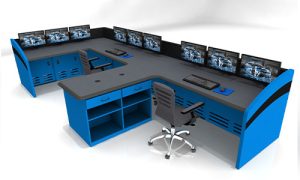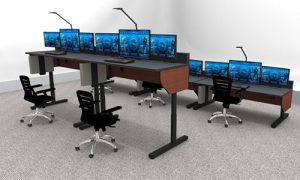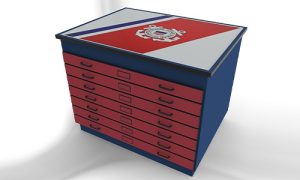Modern Control Room Design Considerations


Ergonomics And Human Factors
When designing a modern control room, the main goal is to combine ergonomics, or the science of optimizing the design of systems, with helping and understanding humans. While ergonomics plays a role in helping humans find comfort and efficiency in their control room roles, there are still psychological and physiological aspects of the environment that only humans can know. The marriage of ergonomics and humanity is crucial to creating a workspace that advances productivity, limits fatigue and minimizes disruption.
Importance Of Ergonomic Design
Ergonomic design in control rooms is not a luxury but a necessity. In modern control rooms, operators often work long shifts where they monitor complex systems or respond to critical situations. Poor ergonomic design can lead to discomfort, musculoskeletal disorders, and lagging operator performance. Here are some key considerations with control room ergonomics:
Workstation Layout: The layout of control room workstations should be designed to minimize physical strain, even down to the placement of monitors, keyboards, and input devices. Everything should be designed to reduce excessive reaching or awkward postures.
Operator Seating: Ergonomic chairs with adjustable features are essential and should support proper posture, provide lumbar support, and accommodate operators of different heights and sizes.
Display Placement: To reduce neck strain, monitors should be positioned at eye level. Adjustable monitor arms can also be beneficial and allow operators to customize their comfort.
Task Analysis: Understanding specific operator tasks and how operators interact with the control system is important in creating an efficient workspace that minimizes cognitive load.
Human Factors In Control Room Design
Beyond the physical aspects of design, human factors delve into the cognitive and psychological elements of operator performance. Human considerations help create an environment where operators can make tough decisions quickly and accurately. Key points to consider include:
Information Display: Information display design should support the rapid digestion of information, presenting critical data clearly with minimal distraction.
User Interface: Control systems should have user-friendly platforms that are easy to navigate. Training time should be minimal, and errors reduced due to the ease of the interface.
Alert Management: Properly managing alarms and alerts is paramount. Overloading operators with too many alarms can lead to alarm fatigue which causes operators to miss critical alarms with catastrophic consequences.
Operator Comfort: When it comes to sustained operator performance, providing comfortable ambient conditions, such as temperature and lighting, is essential. Well-lit workspaces reduce eye strain, and a comfortable temperature keeps operators alert and focused.
Workload Management: Control room design should account for variations in workload. Operators should be equipped with strategies to cope with high-stress situations and have access to the right resources during emergencies.
Layout And Spatial Allocation
How a control room space is laid out is another critical aspect of modern control room design. The layout and spatial arrangement of equipment, workstations, and auxiliary areas play a significant role in determining the efficiency, safety, and functionality of the control room environment. Thoughtful space planning ensures operators can perform their tasks with ease and that the control room can adapt to changing needs and technologies.
To get started with space planning, the first step involves determining the overall layout of the control room, including the specific needs, the number of operators, and the types of equipment to be housed. Some key considerations include:
Zoning: Divide the control room into distinct zones based on the functions in each area. Common zones may include the main control area, monitoring stations, supervisor stations, and auxiliary spaces for meetings, break times, and training.
Operator Sightlines: It’s important that operators have clear sightlines to all critical displays and equipment. Obstructed views and distractions can lead to delays in decision-making and potentially serious errors.
Equipment Placement: Place control consoles, monitors, and input devices in an ergonomic arrangement that minimizes clutter while maximizing accessibility.
Traffic Flow: Allow space for efficient traffic flow within the control room. Operators should be able to move between workstations and zones with ease.
Maximizing Efficiency
When arranging a control room, efficiency is a main goal. Here are some strategies to maximize efficiency in your control room:
Optimal Console Layout: Design control consoles to accommodate the specific needs of operators. For example, frequently used equipment and displays should be within easy reach for operators and organized to reduce fatigue.
Ergonomics: As mentioned before, ergonomics should be integrated into space planning to create a workspace that maximizes comfort and efficiency.
Cable Management: Effective cable management, to keep wires and cables organized and out of the way, not only improves aesthetics but also reduces tripping hazards and maintenance difficulties.
Future Scalability: In order to plan for future growth and technological advancements, consider how the control room layout can accommodate additional equipment or operators without major disruptions.
Minimizing Distractions
Used by everyone from 911 operators to security teams, control rooms are often high-stress environments where operators need to focus and respond to critical tasks. Space planning should minimize distractions and create a workplace that supports efficiency and comfort. Some strategies include:
Noise Control: To reduce noise levels and enhance concentration, implement soundproofing and acoustic treatments in the control room.
Task-Oriented Design: Arrange the workspace by function and minimize non-essential elements or decorations that can distract from critical functions.
Control of External Factors: While natural light can be beneficial, lighting and outside views should be controlled to prevent glare on screens as well as interruption.
Contact Command Watch
For more information on a monitor wall design or to receive a quick quote on command center furniture, control room design, or console accessories, contact Command Watch today.
Contact Information:
(866) 740-2121
cwsales@command-watch.com






